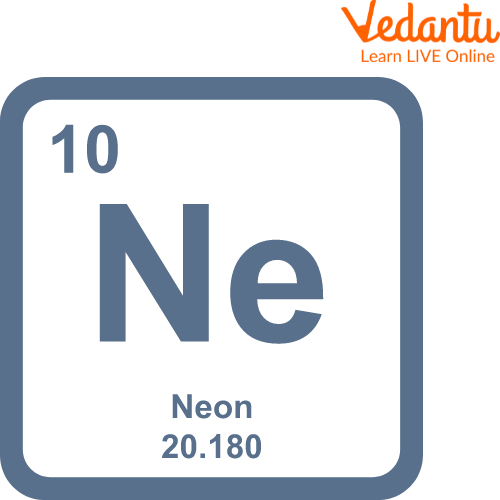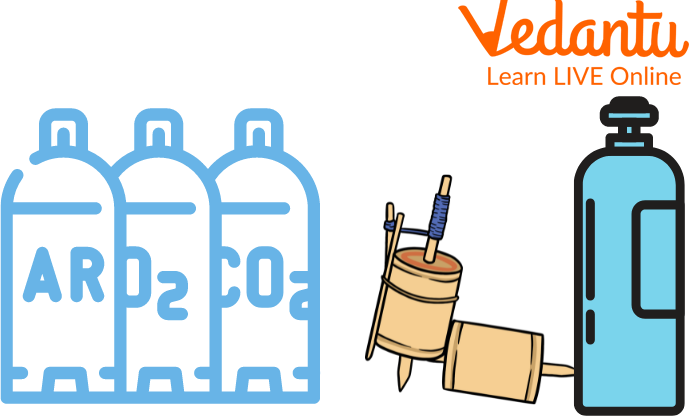




Overview of Neon
While walking on the roads, have you ever seen the beautiful, colourful advertisement signs which are blooming with beautiful lightning on the road? So those beautiful signs are neon, a noble gas used in advertisement signs. Neon is used in our everyday appliances also like television tubes, vacuums, lasers and in many other things.
It's a very normal gas which is not very exciting without electricity. So in this article, we will learn about what is neon used for, some chemical properties of neon and some of its interesting facts. So without wasting more time let's learn more about neon.
What is Neon?
Neon is a type of gas which does not react with anything. It is a chemical element whose atomic number is 10. Given below is a neon element image.

Neon
Neon was discovered in 1898 and it was one of the three residual rare inert elements which remained in dry air after nitrogen, oxygen, argon and carbon dioxide were removed. Neon was the second of the three rare gases. The name neon is derived from the Greek word "neuter" meaning 'new'. Also, its symbol is Ne.
History of Neon

History of Neon
So, neon was discovered in 1898 by two British chemists whose names were Sir William Ramsay and Morris W. Travers. They discovered it as a component of the most volatile fraction of liquefied crude argon which is obtained from air. It was immediately recognised as a new element by its unique glow when it was electrically stimulated. The name neon is derived from the Greek word neos, which means “new.”
Under low pressure, neon emits a bright orange-red light when an electrical current is passed through it. This property is utilised in neon signs, in some fluorescent and gaseous conduction lamps, and in high-voltage testers. And in that, no stable chemical compounds of it have been observed.
Chemical Properties of Neon
Neon, is a chemical element, inert gas of Group 18 (noble gases) of the periodic table, which is used in electric signs and fluorescent lamps.
Neon is colourless, odourless (has no smell), it is tasteless and lighter than the air, neon gas occurs in minute quantities in the earth’s atmosphere and is trapped within the rocks of the Earth’s crust.
Its only commercial source is the atmosphere, which is 18 parts per million by volume. Itts boiling point temperature is −246 °C (−411 °F).
It remains along with helium and hydrogen, in the small fraction of the air that resists liquefaction upon cooling to −195.8 °C (−320.4 °F, the boiling point of liquid nitrogen).
Neon is isolated from a cold, gaseous mixture by bringing it to contact with activated charcoal, which adsorbs the neon and hydrogen; then removal of hydrogen is affected by adding enough oxygen to convert it all to the water, which along with any surplus oxygen, condenses upon cooling. Processing 88,000 pounds of liquid air will produce only one pound of neon.
Facts About Neon
Some interesting facts about neon are as follows:
One of the lesser known neon facts is that REDDISH-ORANGE is the Real neon light because when you fill a clear tube with pure neon gas, it lights up a reddish-orange in colour.
Neon gas is very rare. A rare gas is another name for a noble gas. These six gases form approximately only 1% of the earth’s atmosphere.
Georges Claude displayed his neon lamps at a Paris exhibition, and it was the first neon light that was revealed in 1910.
In January 2017, a neon sign was once sold for 48,300 at an auction night in Maine, USA, the sign was from the legendary Los Angeles rock club, ‘Whisky a Go Go' and it was 13ft long.
Neon lighting is a handmade beautiful art and creators use blow torches to heat glass tubes before bending them into place and sealing them all together.
Uses of Neon

Neon Element
Having unique properties of neon means that neon has many uses in everyday life. Let's discuss some of them. It'sIt's used in advertising signs, vacuum tubes, wave metre tubes, lighting arrestors, television tubes, plasma tubes and helium-neon lasers.
Nowadays liquid neon is commercially available and is used as a cryogenic refrigerant. Neon is often used for producing unmistakable bright reddish-orange light. Although tube lights with other colours are often called "neon", they use different noble gases and varied colours of fluorescent lighting.
Summary
In this article, we have learned many wonderful things about neon. We learnt about what it is, how we use it in our everyday life, and what was the history of neon. Moreover, we learnt the chemical properties of neon and we also discussed some wonderful interesting facts which were related to neon. We have discussed the use of neon and how beautifully the advertisement signs are made; they look so eye-catching isn't it? We also discussed that without electricity neon is not an enjoyable element. We hope you enjoyed reading this article.
FAQs on Facts About Neon
1. Why does using neon require vast experience?
Using glass tubing and neon gas, making a neon sign takes a lot of expertise to master. It takes years to build up the necessary training and skills to make the neon signs to a high standard one.
2. What are the risks with neon?
Inhalation in excessive concentrations can result in dizziness, nausea, vomiting, loss of consciousness, and death when handling the neon gas.
3. Can neon catch fire?
Yes, because neon signs operate at extremely hot temperatures, they can be a fire hazard quite quickly.









